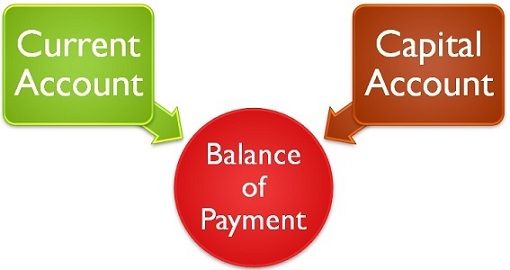 The balance of payment is the record of dealings in goods, services and assets, between the citizens of the nation and the rest of the world. It is divided into two parts, i.e. Current Account and Capital Account. Current Account is an account showing the trade of merchandise, whereas the Capital Account gives place to all capital transactions.
The balance of payment is the record of dealings in goods, services and assets, between the citizens of the nation and the rest of the world. It is divided into two parts, i.e. Current Account and Capital Account. Current Account is an account showing the trade of merchandise, whereas the Capital Account gives place to all capital transactions.
While current account is used to keep a track on the movement of money in and out the economy, during a particular period. The capital account, on the other hand, represents the flow of capital in the economy. It is quite troublesome to understand what matters are considered in the former and what are discussed in the latter. So, here in this article, we’ve presented the difference between capital account and current account, take a read.
Content: Current Account Vs Capital Account
Comparison Chart
| Basis for Comparison | Current Account | Capital Account |
|---|---|---|
| Meaning | An account which records the export and import of merchandise and unilateral transfers done during the year by a nation are known as Current Account. | An account which records the trading of foreign assets and liabilities during the year by a country is known as Capital Account. |
| Reflects | Net Income of the country. | Net change in ownership in national assets. |
| Deals with | Receipt and disbursements of cash and non-capital items. | Sources and application of capital. |
| Components | Trade in goods and services, investment income, unrequited transfers. | Foreign Direct Investment, Portfolio Investment, Government loans etc. |
Definition of Current Account
The Balance of Payment is a set of accounts which comprises of two major accounts, one of which is the Current Account. Current Account is the record of the inflow and outflow of money to and from the country during a year, due to the trading of commodity, service, and income. The account is an indicator of the status of the economy. The major components of a current account are:
- The Balance of Trade (only visible items i.e. goods): Goods imported and exported to and from the country.
- Trading of Services: Services received from other countries and rendered to other nations.
- Net investment income: Income from foreign investment less payments on foreign investments.
- Net cash transfers: Current transfers in the form of donations, gifts, aids, etc. form part of net cash transfer.
Current Account is the record of the exchange of commodities and services for the recent period. It shows the flow of foreign trade. In India, reporting of the account is done by the Central Bank. If the account shows a negative balance, then it means that the imports are greater than exports or consumption exceeds savings. Similarly, if there is a positive balance, then it is a symbol of exports over imports.
Definition of Capital Account
The remaining half of the Balance of Payment is Capital Account, which records the movement of capital in the economy due to capital receipts and expenditure. It recognises foreign investment in domestic assets and domestic investment in foreign assets. The details can be recorded by analysing the inflow and outflow of funds from the nation’s economy. The funds can be in the form of loans or investments.
Under Capital Account, investments made by both public and private sectors are taken together. The capital flow may either be debt creating or non-debt creating. The following are the components of Capital Account:
- Foreign Direct Investment: Investment and control in a company based in a country by a foreign company.
- Portfolio Investment: Investment in stocks, bonds, debts and other financial assets.
- Government loans to the Government of other countries of the world.
Key Differences Between Current Account and Capital Account
The following are the major differences between current account and capital account:
- Current account records the trading in goods and services in the current period. Capital Account records the movement of capital in and out the economy.
- Current Account shows the net income of the country, whereas Capital Account shows the change in the ownership of the nation’s assets.
- Current Account is mainly concerned with receipts and payment of cash and non-capital items. Conversely, Capital Account has thoroughly considered the sources and application of capital.
- The key components of current account are export and import of goods and services, the investment the income and current transfers. On the other hand, foreign direct investment, portfolio investment and Loans by the government of one country to the government of another country are the key components of Capital Account.
Conclusion
If there is an export of goods or services the current account will be credited while if there is an import the account will be debited. In contrast to capital account, if there is a purchase of machinery from a foreign country, then the capital account will be debited whereas if a building is purchased in a country by a foreign country then the account will be credited.
The Balance of Payment is the sum total of both the accounts. Apart from all the differences between the two accounts of the balance of payment, if one account shows surplus the other will show the deficit and vice versa, but at the end, both the accounts will get balanced.






Rajan says
Really good I like it..
Parul mahajan says
thanks so much…I have a problem with this topic ….now it’s clear thanks once again